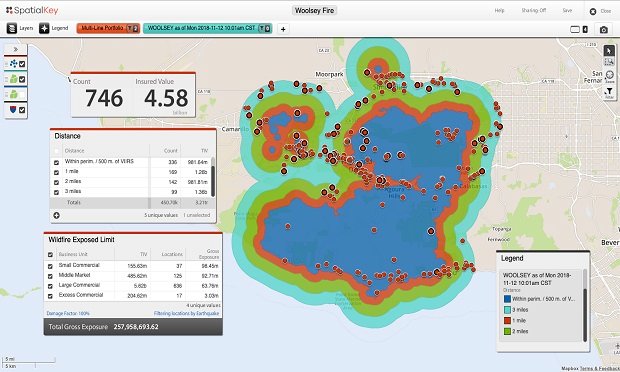Insurers find themselves much more comfortable doing businesswith the private cloud services available on the market todaybecause these services offer a controlled environment that doesn'thave the public perception that their customer data is being storedon servers that also houses data for hundreds of otherbusinesses.
|But that doesn't mean carriers should shy away from using someof the public cloud services, such as Amazon Web Services (AWS),which offer customers nearly unlimited computing power that can beused on an as-needed basis.
|Insurance companies also are using the public cloud for lesssensitive issues, according to Chad Hersh, a partner with theanalyst and consulting firm Novarica. For example, Hersh explainsthat carriers can run actuarial models in the public cloud as longas they have scrubbed the data to the point where it no longer hasany private or sensitive information.
|"Rating models is another great use of [the public cloud]," hesays "Within the AWS cloud you have access to services that youaren't available internally and can be run inexpensively. You canset up a server today, use it, and turn it off today and you onlypay for a few hours of server time. It's a remarkable concept."
|When companies study what they need to perform advanced researchand analytics, Hersh explains companies traditionally have to gothrough the procurement process and wait four to six weeks to get aserver; they would then have to set up the server and test out whatis needed.
|"In the AWS world, that's not even an issue," he says. "You dothat in minutes with a credit card. You pay for it when you use itand you don't pay a dime when you're not using it."
|Bill Hartnett, who runs a consulting firm Hartnett Advisorsafter years heading up Microsoft's insurance practice, compares the reaction of insurers to the cloud to how the Internetwas perceived a decade or ago.
|"When [the Internet] first came around in the late 1990s, theinsurance industry had the same attitude: 'We're never going to putour data on the Internet; it's too risky,'" says Hartnett. "Look atwhere we're at now."
|The insurance industry is extremely risk averse, remindsHartnett, and even more so when it comes to the adoption of newtechnology.
|"This is no exception," he says. "It's accurate to say thateventually you will see a policy administration system in thecloud, but that doesn't mean State Farm is going to wind up withtheir policy admin system in the cloud. There are a lot ofcapabilities making it easier for start-ups or new entrants to takea niche business where smart people with good intellectualhorsepower no longer have to be experts in data processing. You canrent a data processing department (in the cloud)."
|Over the coming years, insurers may have their policyadministration system operating on a private cloud, points outHersh.
|"I think you'll find a good number of vendors are looking to puttogether SaaS solutions that run in a private cloud," he says. "Theother interesting thing is we are seeing more willingness to thinkabout cloud. People are becoming more comfortable with multi-tenantvirtualization, but it remains a tough subject for most carriers.They would just rather not be in multi-tenant environment."
|Hartnett believes economics is a key factor for insurers lookingto move systems or data into a cloud environment.
|"You get to a utility computing model where you pay for what youuse just like electricity," he says. "It's a variable cost modeland not a lot of capital infrastructure to put in place. You don'tneed building space to house a data center or the technical help torun it. It's like your Internet jack or your three-prong plug. Theeconomics of computation and data storage make the cloud attractiveto people."
|Grid Computing
|Hartnett points out the capacity benefit that allows carriers toget massive computational power without building their own clustersor grids can offer a huge savings in hardware.
|"[Grid clusters] would not be available to a small company inthe past without a massive investment," he says. "There also is theeconomics of data storage. When you deal with these volumes,companies like AWS have an immense capacity to store data with hugedata centers. Only companies like Amazon, Microsoft or Google couldafford to make an investment like that, which can benefiteverybody."
|The concepts of the cloud and grid computing are similar interms of distributing the workloads, but Hersh maintains the bigdifference with grid computing is carriers have to optimize theirsoftware specifically for grid because grid computing issubstantially different than running off a single server.
|"You are farming out individual tasks to individual machines,"he says.
|With AWS in the cloud, carriers need to optimize things if theyare running client-facing systems or systems that are run all thetime, but because of virtualization, companies don't have to spreadout the work on a bunch of machines; they can run it on onepowerful machine and they don't have to rewrite their software.
|"There may be a lot of development work that goes into makingyour computer grid-compatible, or you could rent a really big Linuxbox for a few hours from AWS," says Hersh. "With grid, there is apretty substantial investment up front because you have to buy agrid management system. The ongoing costs are small, but theupfront costs are not negligible by any stretch."
|Public vs. Private
|Using the private cloud means it is unlikely insurers are goingto be able to get access to additional computing power on shortnotice, explains Hersh.
|"The private cloud doesn't have the same elasticity as a companylike AWS offers," says Hersh. "With AWS, there is virtually nolimit to the amount of computing power you can get in literallyminutes. With a private cloud you might be able to ramp up with noimmediate notice, but if you are planning to do something very muchout of the ordinary from your profile—such as a large Monte Carlosimulation for risk modeling—you need to let [the cloud operators]know ahead of time to be sure they procure the right hardware."
|If you look at any kind of rating models, financial or riskmodeling or even modeling for pricing, all those are tasks can becompleted by carriers today on their mainframes, according toHersh. But as carriers look to modernize their systems, it becomesappealing to them to not replace the computing power of themainframe because of the price.
|Hartnett points out that the public vs. private debate is moreof a response to concerns about security and privacy. But whatbusinesses are seeking is the ability to take the same architecturethat makes the public cloud so attractive and run it inside theirfour walls.
|"If there's a burst of activity and you don't have the power youneed, you can seamlessly pull in resources from the public cloud,"he says. "You don't have to write code and when you are done withit you don't pay for it anymore. I think that seamless transitionin the architecture makes sense, but the true benefit comes fromthe public cloud. That's where you get the advantage from themassive investment companies like AWS and Google are making and notcreating your own mirror infrastructure internally. Not that theprivate cloud discussion is a bad one. There are some things wherethere will be a fair amount of private cloud purchased, but overtime companies will find they don't need their own data centeranymore. That may be 10 years or more away, but that's not anunreasonable expectation, either."
|Security Issues
|Hartnett believes the security aspect is driving the move to thecloud for a lot of business, though not necessarily for theinsurance industry.
|"Big providers are able to offer a far more secure environmentfor data and computation than you can do on your own," he says."These are centers with very few people there. No one is going tomess with your data. The ability to secure that environment notonly from a physical standpoint but from an electronic standpointis probably better—although I could be proven wrong by some databreach—but it is far less likely you are going to get a data breachat AWS or Azure than you will at your average mid-tier insurancecompany trying to run their own security. The notion is that[cloud] is like the Wild West—it's not safe and you can't trust it.My response is: How did you feel about the Internet when it firststarted."
|Third-party Data
|There is a long history of the insurance industry usingthird-party data sources and integrating them in policy and claimssystems, points out Hartnett. He believes cloud computing probablywill make that easier because of the standards starting to evolvearound that data.
|"If you get a SOA or a Web services approach to building apps,deploying them in the cloud makes them much easier to consume," hesays. "If you use industry-based standards like ACORD to do theintegration it also makes it easier to pull different componentstogether and build a sophisticated app. From a standpoint ofthird-party services, I think you will start to see attention givento all the other data out there that no one's figured out how touse yet. There are companies that have consumer data and track yourretail habits or your cellphone companies that track location."
|Sharing Data
|Hartnett contends insurers will rely on third-party services forstoring and sharing much of the telematics information it will becollecting.
|"The analogy right now would be usage-based insurance is the tipof the iceberg," he says.
|Drivers are willing to share data on their driving habits inexchange for a better rate. Soon, they might be willing to tradeother private information, such as their buying habits.
|"Carriers don't know what you bought online or at Target, butcredit card companies do," he says. Aggregators have all thispurchasing data that allows them to correlate when people aresuddenly purchasing cribs or strollers or when you frequent certainplaces."
|That data is not available to insurance companies now exceptthrough third-party sources. An insurer has your driving record andclaim history, so it's hard to see whether there is any proprietarydata an insurance company would have, according to Hartnett. Whatis proprietary are the algorithms they use to break out relevantdata for underwriting or claims settlement.
|"There is capacity to figure out correlations between certainbehavioral things recorded by third parties to determine what kindof risk you are—good and bad," says Hartnett. "People who might beconsidered good risks based on traditional measures may turn outnot to be and vice versa. The best example of that is howProgressive got started doing personal auto. There specialty atthat time was taking non-standard risks and giving them betterprices because they had a better mousetrap. The more data you getthe more opportunity you have to do things like that."
|Aggregated data, such as telematics, that is not tied topersonal identifiable information eventually will end up in thepublic cloud, explains Hersh.
|"The massive amounts of data that are being crunched fortelematics resembles the work done on rating and pricing," he says."It's a great candidate for the cloud. If you are doing a pilotproject for telematics you are going to collect a huge amount ofdata that you may or may not want to store forever. You may end upbuying a bunch of storage equipment that you may not need. Thecloud fits the profile in terms of reliability, scalability, andcost that might fit in with something like a telematicsproject."
|
Want to continue reading?
Become a Free PropertyCasualty360 Digital Reader
Your access to unlimited PropertyCasualty360 content isn’t changing.
Once you are an ALM digital member, you’ll receive:
- All PropertyCasualty360.com news coverage, best practices, and in-depth analysis.
- Educational webcasts, resources from industry leaders, and informative newsletters.
- Other award-winning websites including BenefitsPRO.com and ThinkAdvisor.com.
Already have an account? Sign In
© 2024 ALM Global, LLC, All Rights Reserved. Request academic re-use from www.copyright.com. All other uses, submit a request to [email protected]. For more information visit Asset & Logo Licensing.








